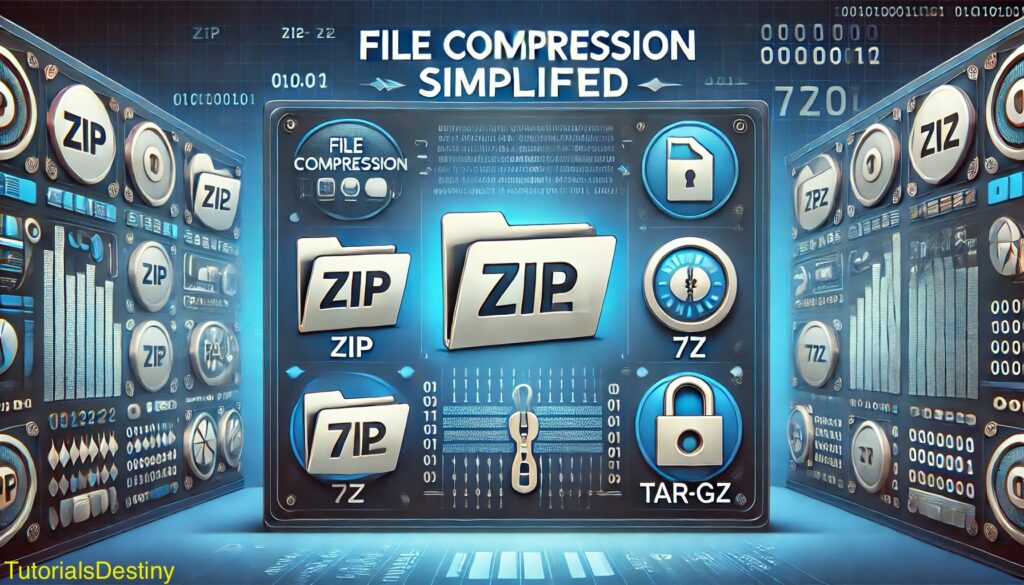File compression is a fundamental process used in computing to reduce the size of files or groups of files. It makes data storage more efficient and facilitates faster file transfer over networks. Let’s dive deep into the concepts of file compression, the most popular compression formats, how they work, and their applications.

What is File Compression?
File compression involves applying algorithms to reduce the size of a file by eliminating redundancy or unnecessary data. The compressed file can then be decompressed to restore the original content. Compression methods can be classified into:
- Lossless Compression:
- Ensures that no data is lost during compression.
- The original file can be perfectly restored after decompression.
- Ideal for text, programs, and sensitive data where accuracy is critical.
- Examples: ZIP, RAR, 7Z, TAR.GZ.
- Lossy Compression:
- Removes non-essential data to achieve higher compression ratios.
- Useful for multimedia files (images, audio, video) where some quality loss is acceptable.
- Examples: JPEG, MP3, MP4.
How File Compression Works
Compression relies on advanced algorithms to find patterns and redundancies in the data and encode them more efficiently. Here’s a breakdown:
- Data Encoding:
- Identifies recurring patterns (e.g., repeated words, pixels, or sequences) and replaces them with shorter representations.
- Examples: Huffman encoding, Run-Length Encoding (RLE).
- Archiving:
- Combines multiple files and directories into a single compressed archive for convenience.
- Archiving does not compress the data by itself but facilitates better management.
- Encryption (Optional):
- Secures the compressed file with passwords or encryption to prevent unauthorised access.
- Common in proprietary formats like RAR and 7Z.
- Compression Algorithms:
- Algorithms such as DEFLATE (used in ZIP) and LZMA (used in 7Z) achieve varying levels of compression efficiency based on the file type.
Popular Compression Formats
- ZIP
- Overview:
- One of the oldest and most widely used formats.
- Supported natively on most operating systems (Windows, macOS).
- Features:
- Lossless compression.
- Allows multiple files and folders to be archived into one.
- Moderate compression ratios.
- Strengths:
- Easy to use and highly compatible.
- Limitations:
- Less efficient compression compared to newer formats.
- Common Tools:
- Built-in OS support, WinRAR, 7-Zip.
- Overview:
- RAR
- Overview:
- Proprietary format developed by RARLAB.
- Known for its higher compression efficiency and robust error recovery.
- Features:
- Higher compression ratio than ZIP.
- Built-in error recovery to fix corrupted archives.
- Strengths:
- Advanced options like multi-volume archiving.
- Limitations:
- Requires specialised tools (e.g., WinRAR) for extraction.
- Common Tools:
- WinRAR, PeaZip.
- Overview:
- 7Z
- Overview:
- Open-source format with exceptional compression ratios.
- Developed by Igor Pavlov for the 7-Zip software.
- Features:
- High compression using LZMA/LZMA2 algorithms.
- Strong AES-256 encryption for secure files.
- Strengths:
- Supports large file sizes and archives.
- Limitations:
- Compression and extraction are slower than other formats.
- Common Tools:
- 7-Zip, PeaZip.
- Overview:
- TAR.GZ (or TGZ)
- Overview:
- Popular in UNIX/Linux environments.
- Combines two processes: TAR (archiving) and GZIP (compression).
- Features:
- Lossless compression.
- Preserves file system metadata (permissions, timestamps).
- Strengths:
- Ideal for packaging software and backups.
- Limitations:
- Not as user-friendly for non-Linux users.
- Common Tools:
- Linux command-line utilities, 7-Zip, WinRAR.
- Overview:
Comparison of Compression Formats
| Feature | ZIP | RAR | 7Z | TAR.GZ |
|---|---|---|---|---|
| Compression Ratio | Medium | High | Very High | High |
| Encryption Support | Basic | Advanced | Strong (AES) | Limited |
| Cross-Platform | Yes | Limited | Yes | Yes |
| Error Recovery | No | Yes | Yes | No |
| File Splitting | No | Yes (multi-part) | Yes (multi-part) | No |
| Ease of Use. | Very High | Moderate | Moderate | Low (CLI-based) |
Advantages of File Compression
- Saves Storage Space: Reduced file size minimises disk usage, especially for backups or large datasets.
- Improves Transfer Speeds: Smaller files are faster to upload, download, or transfer over a network.
- Simplifies File Management: Multiple files can be combined into one archive for better organisations.
- Enhanced Security: Encryption features protect sensitive data from unauthorised access.
Disadvantages of File Compression
- Time-Consuming: Compressing and decompressing large files can take time, especially with advanced algorithms.
- Risk of Data Loss: Corrupted archives may become irrecoverable without error recovery features.
- Tool Dependency: Some formats, like RAR, require proprietary software for access.
- Compatibility Issues: Older systems may not support modern formats like 7Z or TAR.GZ.
Applications of File Compression
- Backup and Archiving: Reduce space for storing backups while retaining all file metadata.
- File Transfer: Accelerate sharing of files over email or cloud storage.
- Software Distribution: Bundle multiple files (e.g., installers, dependencies) into a single archive.
- Data Security: Encrypt sensitive files before transmission.
Common Compression Tools
- Windows: WinRAR, 7-Zip, PeaZip, Built-in ZIP support.
- macOS: Keka, The Unarchiver, Built-in ZIP support.
- Linux: Command-line tools like tar, gzip, and bzip2.
- Cross-Platform: 7-Zip, PeaZip, WinRAR.
Conclusion
File compression is a versatile tool in modern computing, allowing users to optimize storage, enhance file sharing, and secure data. By understanding the differences between formats like ZIP, RAR, and 7Z, and the tools available, users can make informed decisions about how to manage and store their digital files efficiently.
Leave a Reply